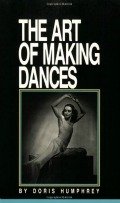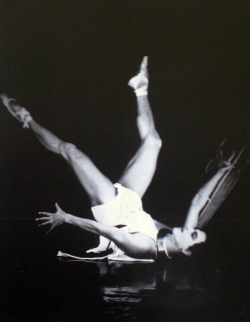| Back to Back Issues Page | |||||
 |
|||||
|
THE CHOREOGRAPHER'S MANIFESTO by S. Lifar, The Dance Thinker, Issue #9 July 23, 2011 |
|||||
The Dance Thinker Issue # 9, July 23, 2011
1. Check out this great new page at our section for modern dance history: Doris Humphrey
1. THE CHOREOGRAPHER’S MANIFESTO by Serge Lifar
https://www.contemporary-dance.org/The_Dance_Thinker-choreographers-manifesto.html
We have: - A page for contemporary dance announcements in which you can post your news about workshops, auditions, performances, meetings or any current, related items. - A contemporary dance blog where you can find current information and that will automatically distribute what you post in the announcements page to facebook, twitter and all subscribers to the site’s RSS feed. - A worldwide, contemporary dance directory of schools, companies and websites to which you can also submit your contact information. - A special page for asking dance questions. - Several pages in which you can participate with contributions like articles, reviews, questions, ratings or comments. - An archive for THE DANCE THINKER back issues, where you can always revisit precedent issues from our e-zine. - A contact page through which you can address to me directly if you have questions, ideas, wishes, suggestions or comments.
News
You will see that there is expanded information about her work in the page and a good surprise for those who had been lazy till now to read her book “The art of making dances”: I made a review of it with a short summary of its main content. Teachers, choreographers and researchers… this might be of use. I hope you like it. Don´t hesitate to send me some feedback. I’d love to hear comments. 1. THE CHOREOGRAPHER’S MANIFESTO by Serge Lifar
Some days ago, I was listening to the contemporary dance choreographer Siobhan Davies talk about the making of her piece “Bird Song”. She explained that at the beginning of the process she felt like avoiding to use a specific music, because she didn’t want to have a predetermined structure to work over. Her statement made me remember Noverre, and the fact that even after so many years of the edition of his ideas, choreographers are still in the search of what the autonomy of dance is. I believe, just like Siobhan Davies seems to express, that the creation of the dramatic structure of a dance piece is one of the main acts that determines the autonomy of the choreographer from the musician or the playwright. Defining a dramatic structure is for me at the core of generating a choreographic event, regardless of its nature. If the choreographer uses a predetermined structure created by a musician, playwright, visual artist or anything likewise, s/he would miss the fundamental experience of proposing the basic form of her/his creation. Before I had lost myself in particular considerations about that matter, I remembered that at the very heart of the so called modernity of dance (beginning of the XXth century), Serge Lifar insisted in his own way over the same subject. I have knowledge of this because of a quotation that I found in a French book about dance history (“La danse au XXième siècle”). The title of the referenced text is “Le Manifest du chorégraphe”. I have tried to share the manuscript with students and friends, but unfortunately the French language is not very wide spread where I live. And as it seems to me, that text is still not available in English in the web, except for some short passages that promote the whole book that has the same name, also by Serge Lifar. So, I thought of translating it, as I believe that even if it talks in the voice of the beginning of the XXth century, it summarizes a good group of related ideas for choreographers to consider. I hope this is of use for some of you or that at least it makes your creative mind work over a few questions and possible answers. So, here’s the text:
THE CHOREOGRAPHER’S MANIFESTO
That does not mean that I pretend to impoverish ballet by depriving it from its musical decoration (there’s no one as suitable as a choreographer for measuring the emotional effect of music over dance and -let’s name things as they are- over our bodies). However, I admit the possibility of existence of a ballet without musical accompaniment. More than that: a ballet -with or without music- should emerge spontaneously from its own elements and not from music. As the choreographer that I am, I compose a ballet, I write it down and I present it to an audience. I write it down… Until now, tradition has only allowed certain ballets to survive, enriching the verbal transmission of musical contexts only. But currently, we posses an unexploited writing mean: the cinema. The cinema can allow masses to know ballet. Furthermore, it can register it, assure its permanence and become some kind of ‘edition’ of ballet. Recorded like this, ballet becomes from all perspectives comparable to a printed poem. The musician can be inspired by it, as s/he is by a poem, and can compose a score over the rhythmical outline of my dance and enrich it with new flames. All this, in the same way that I can find inspiration in an ancient myth, in “The Divine Comedy”, in a piece of modern literature, etc.. All poems, even if they are based on rigorous rhythmical patterns, can give birth to several different melodies. Why wouldn’t it be the same regarding a film of mute choreography? My rhythmical pattern leaves the musician’s freedom of inspiration intact. Even more: let’s suppose that I create a movement that lasts two half notes. The musician can do two half notes, four quarter notes, etc., considering that s/he does not transform my rhythm. Musician and choreographer are placed equally, but the way I propose -from ballet to music and not from music to ballet- seems to me to be the right one because on the one hand we can not dance everything, and on the other hand all dances possess a rhythmical potential that can communicate to music. There can be two types of ballets: with or without music. What should we prefer? As a choreographer, I answer without doubting: ballet with music. Because it would be short saying that we like music: often she is indispensable. In music we find the necessary accents to our psycho-physical movement and our elevation. In music we find the emotions, the forces, the inspiration demanded by our impetus: ‘Excelsior’! I do not really have the right to talk about the musical field, though it is very familiar to me. However, I dare making a shy comment about the music for ballet: it needs its special orchestra. But it is the task of the musician and not of the choreographer to think it out. Another comment: the choreographer should not try to impose her/him self in the field of another autonomous art: painting. And the painter as well, should consider the particularities of ballet when s/he composes a model. S/he should inspire her/him self from the choreography, supply the dancer with the more suitable costumes and try to highlight the plastic elements of the role, instead of crushing them as s/he has the tendency to do. For the big synthesis to arrive, it is necessary that each of the arts has first its own free development. Ballet -I don´t speak for other arts or I’d make the figure of an intruder- needs to engage in a new path that is its path. Ballet should know that: 1. We can not, we should not dance to anything. 2. Ballet should remain tied to its source: dance. 3. Ballet should not be the illustration of another art. 4. Ballet should not borrow its rhythmical pattern from music. 5. Ballet can do without music. 6. Ballet can and should be written down. 7. In the case of ballet associated with music, the rhythmical base should be created by the choreographer and not by the musician. 8. Ballet needs a special orchestra. 9. The choreographer should not be the servant of the painter. 10. It is necessary to found an autonomous choreographic theater.
Those are the essential principles of a choreographer’s manifesto.
Some of you, mature artists and choreographers, might want to tell me that this is so obvious, that we could forget about the matter now. What I personally see in the dance composition classes I teach is that this is not true at all. There are many forms of dance that use music and/or texts to rely on their dramatic structures. And this seems to create a tendency to believe that this is also the creative approach of contemporary dance. So, I believe that remembering this from time to time can be healthy. I personally do not think that it is wrong to lean over dramatic structures created by others (musicians, playwrights or whatever). However, I kind of feel that there’s a fundamental act of expression and creation in the act of proposing the structure of a piece. I ask my self if working in this way would not construct the status of autonomy we’ve been talking about since Noverre’s time…
If you can not view this message correctly, please copy and paste the following link in your browser's address bar: https://www.contemporary-dance.org/The_Dance_Thinker-choreographers-manifesto.html
Remember to feel free to answer this e-mail. Let me know what you think. I’m always opened to comments, suggestions, ideas, wishes…
Editor and Webmaster of contemporary-dance.org
|
|||||
| Back to Back Issues Page |
 1. We have a great new page at our section for modern dance history. This time the turn is for
1. We have a great new page at our section for modern dance history. This time the turn is for 